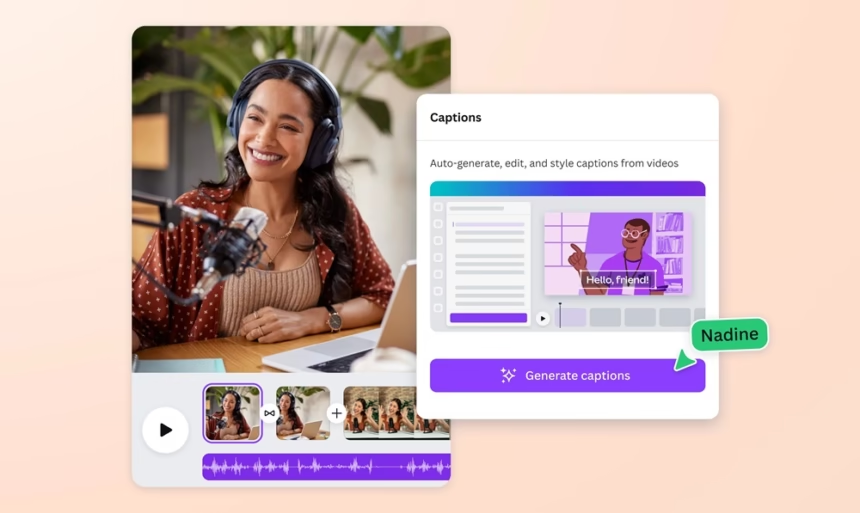Social feeds in 2025 moved fast. Brands and creators need captions that feel real, match a voice, and fit each platform. An AI caption generator that writes like humans turns ideas into posts that read smoothly, stay on-brand, and get results. In simple terms, it uses your context, tone, and platform rules to produce human-like captions with the right length, style, and hashtag suggestions, then supports analytics to learn what works.
This guide shows what human writing looks like in captions, the features to expect, how to choose a tool, and prompt recipes for Instagram captions and TikTok captions that sound natural.
What Makes an AI Caption Generator Sound Human
A human-like caption talks to a person, not an algorithm. It notices what is in the photo or video, keeps a steady tone, and ends with a clear next step. It also fits the platform and avoids overused lines.
- Natural language and context: It refers to the scene, the product, or the story, not generic filler.
- Tone of voice: It sounds like the brand, and can switch from playful to helpful or professional.
- Clear purpose: A hook, a bit of value, a call to action, and one simple next step.
- Platform fit: Length, spacing, emojis, and style that match Instagram, TikTok, or LinkedIn.
- Freshness: New wording that avoids clichés and repeats.
- Safety: No risky claims, biased language, or off-brand topics.
Quick contrast:
- Robotic: “Check out our new product. Buy now. #sale”
- Human-like: “First sip, instant calm. New chamomile blend is live today. Want the first pick, or should we save you a tin?”
Checklist to remember: Does it read smoothly, sound on-brand, fit the platform, and invite a response?
Natural Language and Context, Not Stiff Text
A good caption reacts to what people see and what they need. It ties the image or clip to the audience goal and the brand promise.
- Before: “We are excited to present our new shoes.”
- After: “Mud on the trail, clean grip on every step. The Ridge 2.0 drops Friday. Which color gets your miles?”
Why it works:
- Context words: mud, trail, grip.
- Sensory details: miles, color, Friday drop.
- Simple verbs: drops, gets, steps.
Tone Matching to a Brand Voice
A strong tool learns voice from a few samples or a style guide. Expect tone sliders like:
- Friendly to formal
- Playful to expert
- Bold to calm
Tone should stay consistent across posts, while the platform format shifts. A brand can be friendly and expert on Instagram, then slightly more formal on LinkedIn without losing its core phrases.
Platform-Ready Captions for Instagram, TikTok, and LinkedIn
The same message should change shape by platform:
- Instagram: Hook up top, short lines, skimmable structure, 3 to 10 hashtags.
- TikTok: Short punchy text, strong first line, 2 to 5 hashtags.
- LinkedIn: Clear value, light story or insight, professional CTA, few or no hashtags.
Ideal ranges:
- Instagram: 100 to 2200 characters, but 140 to 300 reads well.
- TikTok: 20 to 150 characters for speed.
- LinkedIn: 140 to 300 words or less, clear spacing.
Ethical and Safe Writing
Review claims for accuracy. Avoid medical or legal advice unless qualified. Respect copyright for quotes and lyrics. Use inclusive language. Do a quick pass to catch sensitive topics, and keep claims grounded.
Key Features to Look For in 2026
Modern tools make everyday posting faster and safer. A simple buyer checklist:
- Tone controls and style presets: Brand voice profiles and mood selection for consistency.
- Hashtag suggestions: Fresh, relevant tags that mix broad and niche.
- Trend awareness: Seasonal prompts, product drops, and relevant events.
- Multilingual and localization: Natural phrasing for regions, not just direct translation.
- Editing, collaboration, approvals: Drafts, comments, and roles for teams.
- Analytics and A/B testing: Hook tests, CTA tests, and time saved reports.
- Platform-aware formatting: Line breaks, character limits, emoji placement.
- Shortcuts: Caption variants, alt text suggestions, first comment hashtags.
Natural Language Engine With Tone Controls
Sliders and presets help non-writers stay consistent. Keep 2 to 3 voice presets:
- Playful
- Educational
- Executive
Save strong examples in each tone to train the model over time.
Smart Hashtag Suggestions and Trend Signals
Use a mix of broad, mid, and niche tags. Aim for:
- Instagram: 3 to 10 tags
- TikTok: 2 to 5 tags
- LinkedIn: zero to a few, only when helpful
Quality beats quantity. Tags should match the post content, not only the brand.
Multilingual and Localization Support
Good tools adapt tone and idioms, not just translate words. For key markets, ask a local reviewer to spot awkward phrases. Test Spanish, French, or other target languages if the audience is global.
Editing, Collaboration, and Approvals
Look for shared folders, roles, and draft comments. Add a quick legal review if needed. Version history and restore options protect teams from mistakes.
Analytics and A/B Testing That Teach What Works
Track simple metrics:
- Saves, shares, comments
- Click-through and watch time
Test hooks, CTA lines, and emoji use. Change one thing at a time. Wait long enough to see a clear result.
How to Choose the Best AI Caption Generator for a Workflow
A clear path helps teams decide in one sitting.
- Define goals: growth, clicks, sales, community.
- Map platforms: Instagram, TikTok, LinkedIn, and others if needed.
- Gather voice samples: top posts, brand guidelines, phrase do’s and don’ts.
- Set must-haves: tone presets, hashtag tool, analytics, team access.
- Trial with real posts for one week, then score results.
- Check budget and scale needs.
Simple scorecard: readability, on-brand feel, time saved, engagement lift, cost per user.
Match the Tool to the Goal and Team Size
- Solo creators: Choose a simple tool with fast drafts and easy edits.
- Small brands: Use tone presets, hashtag help, and platform formatting.
- Agencies: Prioritize collaboration, approval flow, and analytics across clients.
Budget and Plans: Free vs Paid, What to Expect
Free tools draft quick captions. Paid plans add brand voice profiles, analytics, and team seats. Start free, then upgrade if time saved or engagement rises.
Test Drive With a Simple Scorecard
Score each caption 1 to 5 on:
- Clarity
- Tone match
- Platform fit
- Edit time
- Engagement after posting
Keep the top two tools for a 14 day trial before choosing.
Data, Privacy, and Compliance Questions
Ask how data is stored, if your content trains the system, and how to opt out. For regulated teams, look for audit logs, user permissions, and export options.
Popular AI Caption Generators in 2026 and When to Use Each
Several well known options stand out for social teams in 2025. Tools highlighted by current roundups include QuillBot, Later’s Free Caption Generator, Pallyy, HubSpot’s AI post generator, and Hootsuite’s OwlyWriter. They support tone choices, hashtag ideas, scheduling, and performance insights.
ChatGPT: Flexible and Fast for Many Styles
Good for brainstorming hooks, writing variants, and shifting tone by platform. Save prompts as templates and use system instructions to lock voice traits and banned phrases.
Kapwing: Strong for Video Captions and Styling
Helpful for auto-captions in clips, speaker detection, and text styling. Pair on-screen text with a concise post caption for clarity.
Hootsuite Caption Generator: Quick and Simple
Useful for fast drafts across major platforms. Best for teams already planning and scheduling in Hootsuite.
Canva, Jasper, and Copy.ai: Built-In Caption Help in Content Tools
Handy when design, copy, and scheduling live in one place. Helps keep branding consistent and speeds up the workflow.
QuillBot, Later, Pallyy, HubSpot, and OwlyWriter
- QuillBot: Multiple tones, collaboration, and checks for tone consistency.
- Later’s Free Caption Generator: Ideas tied to trends and posting schedules, with hashtag tips and analytics.
- Pallyy: Two caption options per brief, save for reuse, integrates with scheduling.
- HubSpot: Channel-aware posts with performance tracking inside the platform.
- OwlyWriter by Hootsuite: Event-based prompts and quick drafts that fit planning calendars.
Prompt Recipes and Templates That Make Captions Feel Human
Use these patterns to turn ideas into clear posts. Test two variants per post and keep the winner.
The 4 Part Caption Formula
Template:
- Hook: short, curious line.
- Value: one useful tip, story beat, or benefit.
- CTA: ask for a response or a click.
- Hashtags: targeted, mixed sizes.
Example for a coffee brand:
- Hook: “Ready in 60 seconds, tastes like a slow pour.”
- Value: “New pods use the same beans as our top café roast.”
- CTA: “Team bold or team smooth, drop your pick.”
- Hashtags: #coffeetime #homebarista #coffeepods #morningroutine
Tone Switches That Stay On Brand
Keep core phrases, shift the mood.
- Playful: “Your morning wingman in a mug.”
- Educational: “Short extraction keeps acidity low and sweetness high.”
- Professional: “Brew faster while keeping flavor intact.”
- Sincere: “Made to bring calm to busy mornings.”
Tip: Save three voice presets and reuse them.
Platform Templates for Instagram, TikTok, and LinkedIn
- Instagram: Hook, blank line, two short value lines, CTA, 3 to 10 hashtags. Emojis can help scannability.
- TikTok: One sharp hook, one value line, strong CTA, 2 to 5 hashtags. Keep it tight.
- LinkedIn: Brief insight, one example or stat, professional CTA, minimal hashtags. Skip emojis if they feel off-brand.
A/B Caption Ideas and Reading Results
Test one element at a time:
- Two hooks, same body.
- Two CTAs, same hook.
- With emoji vs no emoji.
Watch saves, shares, comments, click rate, and watch time over 7 to 14 days. Keep winners as future templates.
Conclusion
Human-like captions are clear, on-brand, and ready for the platform where they live. The fastest path is simple: choose must-have features, trial tools with real posts, score results, then adopt the option that saves time and lifts engagement. Copy the prompt recipes above and test two variants on the next post. Small wins stack fast. Start today and let the data guide the next caption.















